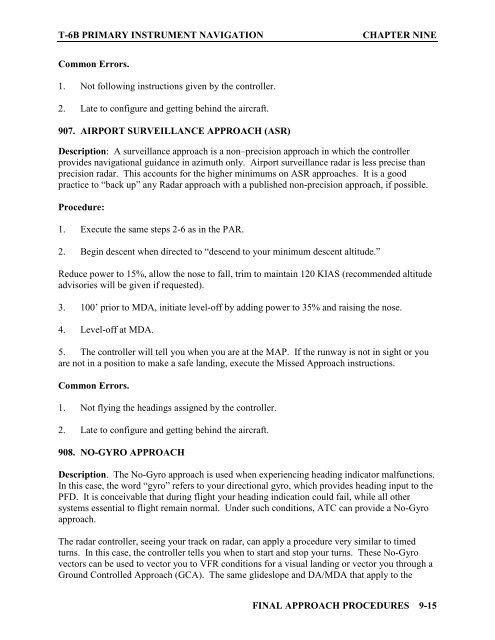Flight Training Instruction - Cnatra - U.S. Navy
Flight Training Instruction - Cnatra - U.S. Navy
Flight Training Instruction - Cnatra - U.S. Navy
You also want an ePaper? Increase the reach of your titles
YUMPU automatically turns print PDFs into web optimized ePapers that Google loves.
T-6B PRIMARY INSTRUMENT NAVIGATION CHAPTER NINE<br />
Common Errors.<br />
1. Not following instructions given by the controller.<br />
2. Late to configure and getting behind the aircraft.<br />
907. AIRPORT SURVEILLANCE APPROACH (ASR)<br />
Description: A surveillance approach is a non–precision approach in which the controller<br />
provides navigational guidance in azimuth only. Airport surveillance radar is less precise than<br />
precision radar. This accounts for the higher minimums on ASR approaches. It is a good<br />
practice to “back up” any Radar approach with a published non-precision approach, if possible.<br />
Procedure:<br />
1. Execute the same steps 2-6 as in the PAR.<br />
2. Begin descent when directed to “descend to your minimum descent altitude.”<br />
Reduce power to 15%, allow the nose to fall, trim to maintain 120 KIAS (recommended altitude<br />
advisories will be given if requested).<br />
3. 100’ prior to MDA, initiate level-off by adding power to 35% and raising the nose.<br />
4. Level-off at MDA.<br />
5. The controller will tell you when you are at the MAP. If the runway is not in sight or you<br />
are not in a position to make a safe landing, execute the Missed Approach instructions.<br />
Common Errors.<br />
1. Not flying the headings assigned by the controller.<br />
2. Late to configure and getting behind the aircraft.<br />
908. NO-GYRO APPROACH<br />
Description. The No-Gyro approach is used when experiencing heading indicator malfunctions.<br />
In this case, the word “gyro” refers to your directional gyro, which provides heading input to the<br />
PFD. It is conceivable that during flight your heading indication could fail, while all other<br />
systems essential to flight remain normal. Under such conditions, ATC can provide a No-Gyro<br />
approach.<br />
The radar controller, seeing your track on radar, can apply a procedure very similar to timed<br />
turns. In this case, the controller tells you when to start and stop your turns. These No-Gyro<br />
vectors can be used to vector you to VFR conditions for a visual landing or vector you through a<br />
Ground Controlled Approach (GCA). The same glideslope and DA/MDA that apply to the<br />
FINAL APPROACH PROCEDURES 9-15
















